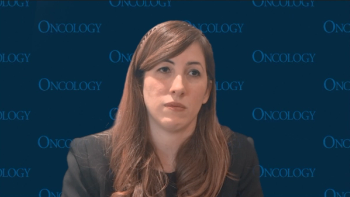
- Oncology Vol 29 No 4_Suppl_1
- Volume 29
- Issue 4_Suppl_1
(P089) p16 as a Complementary Prognostic Marker for EBV-Positive Nasopharyngeal Carcinoma
Our results suggest that p16 overexpression can act as a marker for PFS and LRC in EBV-positive nasopharyngeal carcinoma patients. This interesting finding raises the possibility of further stratifying more aggressive phenotypes within EBV-positive tumors. Therefore, molecular testing of p16 expression may complement EBV status to provide more detailed and comprehensive guidance in determining the prognosis and predicting treatment outcomes for patients diagnosed with nasopharyngeal carcinoma.
Wen Jiang, MD, PhD, Paul Chamberlain, Erich Sturgis, MD, Adam S. Garden, MD, Jack Phan, MD, PhD; UT MD Anderson Cancer Center
BACKGROUND: p16, also known as cyclin-dependent kinase inhibitor 2A, is a tumor suppressor protein that hinders cell cycle progression by inhibiting the formation of cyclin-dependent kinase complexes. Overexpression of p16 is associated with improved outcomes in oropharyngeal carcinoma patients. However, its role in nasopharyngeal cancer pathogenesis remains incompletely understood. Here, we set out to determine whether p16 overexpression status acts as a prognostic marker among nasopharynx cancer patients.
METHODS: We retrospectively identified 86 patients with nasopharyngeal carcinoma who were treated at MD Anderson from 2000 to 2014. Epstein-Barr virus (EBV) status was determined by in situ hybridization, while p16 expression was analyzed by immunohistochemistry. All statistical analyses were performed using the IBM Statistical Package for the Social Sciences (SPSS) v22.0 software package.
RESULTS: A total of 44 patient samples were EBV-positive, and 40 were p16-positive. EBV positivity was associated with improved survival (44.9 vs 95.0 mo; P < .004), progression-free survival (PFS) (28.1 vs 80.4 mo; P < .013) and time to locoregional failure (expressed as duration of locoregional control [LRC]) (65.5 vs 104.4 mo; P < .043). Although p16 overexpression showed trends toward improved PFS and LRC, they failed to reach statistical significance. Overexpression of p16, however, was found to be a significant predictor for improved PFS (27.1 vs 106.3 mo; P < .02) and LRC (64.5 vs 93.6 mo; P < .02) in EBV-positive nasopharyngeal cancer patients using both univariate and multivariate analysis.
CONCLUSION: Our results suggest that p16 overexpression can act as a marker for PFS and LRC in EBV-positive nasopharyngeal carcinoma patients. This interesting finding raises the possibility of further stratifying more aggressive phenotypes within EBV-positive tumors. Therefore, molecular testing of p16 expression may complement EBV status to provide more detailed and comprehensive guidance in determining the prognosis and predicting treatment outcomes for patients diagnosed with nasopharyngeal carcinoma.
Proceedings of the 97th Annual Meeting of the American Radium Society-
Articles in this issue
Newsletter
Stay up to date on recent advances in the multidisciplinary approach to cancer.

















































































